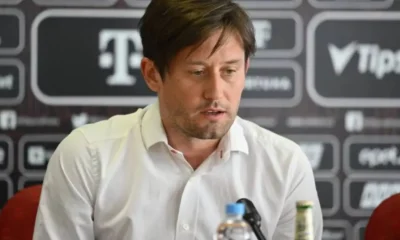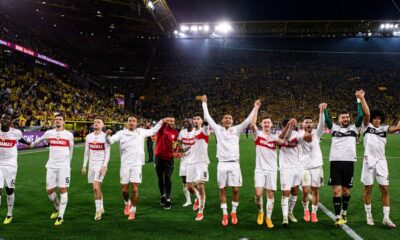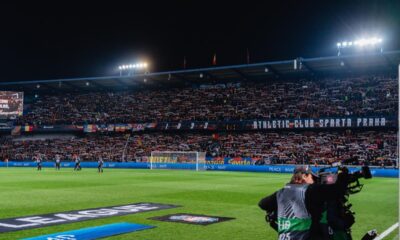Europa League
How did Vrba outperform Gerrard? Precise play without the ball and reaction to the flow of the game
Sparta can celebrate. In front of ten thousand children’s fans, Pavel Vrba’s charges showed an excellent tactical performance and took the all-important three points from the crucial match before the derby. The experienced coach will be all the happier after seeing how his tactics worked against Rangers.
Sparta can celebrate. In front of ten thousand children’s fans, Pavel Vrba’s charges showed an excellent tactical performance and took three very important points from the crucial match before the derby. The experienced coach will be all the happier after seeing how his tactics worked against Rangers.
It was already looking like Sparta’s crucial period of the season would end in a fiasco. After the loss in Pilsen, the Prague team failed to win the next two games. Although they tuned up for Rangers with two wins in Moravia, a defeat just three days before the derby could have devastating consequences.
Thus, Pavel Vrba decided to spare no effort and take on the Scottish champions in the best he currently has at his disposal. With two strikers in the starting line-up, he also made it clear that he is going to Letná – unlike the trip to Copenhagen – for three points. It couldn’t be otherwise with the ambitions of promotion.
The only surprise was the inclusion of Minchev in the starting line-up. But he managed to replace the more expected Drchal in one of the toughest games of his career. In particular, he showed great fight, but lacked more calmness and quality in the final phase.
Tactics in the first half
But now back to the team tactics that Pavel Vrba had set for the home side. Rangers started in a 4-3-3 formation, with wingers with stronger inside legs, offensive midfielders and a technically gifted midfield trio.
Thus, the Scottish team looked for solutions in the midfield especially, where the trio of Kamara, Davis and Bacuna rotated and released relentlessly. The fullbacks both played with an offensive approach, looking for space for the tandems, which opened up behind the wingers withdrawing on the axis.
In return, Sparta set up a high press for the Rangers, which was mainly taken care of by the Hložek – Minčev pairing. The wingers concentrated on consistently defending the flanks and the back line of Tavernier and Barisic.
Minchev was often pushing between the stoppers and splitting the play to one side, where he was supported by Hložek pressing the most stretched midfielder at any given moment. At the same time, the large movement of the visitors’ midfield pulled Pavelka or Sacek to higher positions, who also actively supported the pressing.
At certain moments, the Spartans even settled into a 4-4-2 formation, with Hložek and Minčev in front of Sáček and Pavelka. In any case, the Rangers players didn’t like the active pressing, so it’s no wonder that from the very beginning they were instructed from the bench to set up a three-man lineup. Often, especially the experienced Davis would get in between the stoppers and help the play.
Sparta, on the other hand, set up the play in a completely different way. It was necessary to adapt to Hložek, who doesn’t have the playmaker attributes that offensive midfielders often have in a 4-2-3-1 formation.
This is because traditionally Sparta would regroup on the ball in a 325 formation, with Pavelka at stopper, a pair of midfielders in front of them and the outside backs up at wing-back level. However, Hložek is not the player for the aforementioned withdrawn pair of midfielders, so the formation had to be changed.
Both Wiesner and Hancko were “on the range” of the stopper pair, as well as Pavelka and Sacek. Compared to the domestic competition, the Leten players concentrated more on quick, straightforward transition and did not put as much emphasis on ball possession, which is summed up by the final statistic of 42%. In comparison, in the league, Sparta only got below 60% dominance in the games against Bohemians and Zlín.
Filip Panák was once again outstanding in the midfield. He notched up an impressive 91.7% passing success rate (the best on the field excluding substitutes), including six accurate long balls. All of them were directed to the left side, mostly to Hancock, who operated in a slightly higher position than his teammate Wiesner.
Tactics in the second half
The second half brought big changes in the tactics of both teams. However, they were initiated by the English coach, who opted for a much more offensive style of play. He changed the formation of his charges to the 4-3-1-2 formation practiced in the last league game.
But the main thing was that the flankers had even more offensive tasks than before. They practically acted as wingbacks in a three-stopper formation, in order to maintain the width of an otherwise rather narrow formation.
In contrast, the midfield trio, supplemented by Ariba, was spread wide, with Hagi operating under strikers Roofe and Sakal in the number ten position. Rangers were thus often relegated to a 2-3-5 formation that didn’t have the most solid defensive presence when losing the ball.
But Sparta were able to exploit the risks Gerrard decided to take almost perfectly. The sprawling midfield was manned by wingers Haraslín and Pesek, the central midfield was guarded by Hložek and Minchev again split the visitors’ tracking duo.
The outstretched outside backs were thus secured mainly on the left side by Pavelka. On the right, Sáček was often more stretched out and left back Barišić was guarded by Pešek. When the ball was won, the fast offensive quartet did not hesitate to launch a lightning counterattack, which in the second half often resulted in a great opportunity. However, coach Vrba’s charges failed to add an insurance.
Nevertheless, Sparta went on to win 1:0, did not let the opponent into any major opportunities, on the contrary, they could have increased the goal difference by a lot. Probably the only minus at Letná was the productivity on Thursday, who knows what would have happened in the end if Sparta hadn’t been given a more or less comfortable ending by Glen Kamara’s unnecessary clearance.
Whoscored












